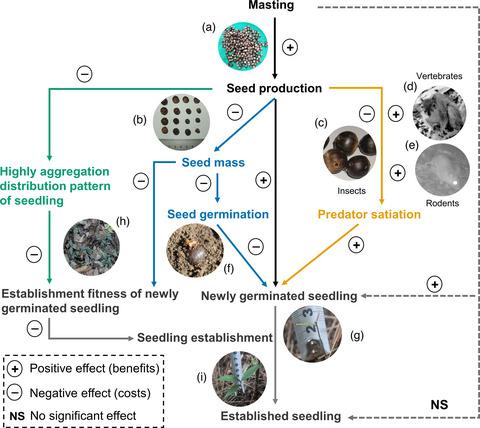Our official English website, www.x-mol.net, welcomes your feedback! (Note: you will need to create a separate account there.)
Benefit versus cost trade-offs of masting across seed-to-seedling transition for a dominant subtropical forest species
Journal of Ecology ( IF 5.5 ) Pub Date : 2021-06-04 , DOI: 10.1111/1365-2745.13722 Li Huang 1 , Cheng Jin 1 , Lihua Zhou 1 , Kun Song 2 , Shenhua Qian 1 , Dunmei Lin 1 , Liang Zhao 1 , Bo Chen 3 , Enrong Yan 2 , Richard Michalet 4 , Yongchuan Yang 1, 5
更新日期:2021-08-10
Journal of Ecology ( IF 5.5 ) Pub Date : 2021-06-04 , DOI: 10.1111/1365-2745.13722 Li Huang 1 , Cheng Jin 1 , Lihua Zhou 1 , Kun Song 2 , Shenhua Qian 1 , Dunmei Lin 1 , Liang Zhao 1 , Bo Chen 3 , Enrong Yan 2 , Richard Michalet 4 , Yongchuan Yang 1, 5
Affiliation

|
- Masting is a common reproductive strategy regulating seedling regeneration in many perennial plant species. The evolutionary origins and functional benefits of masting have been explained by well-supported hypotheses relating to economies of scale of seed production. Nevertheless, our understanding of the potential costs of masting for the plant seed-to-seedling transitions remains limited.
- We tracked the seed fate and documented changes in the seed spatial distribution patterns during the seed-to-seedling transition process of Castanopsis fargesii, a dominant species of subtropical evergreen broad-leaved forests in China under natural conditions for more than 6 years.
- Masting resulted in a high proportion of seeds escaping predation by vertebrates and rodents, supporting the predator satiation hypothesis. However, it increased the pre-dispersal seed predation by insects, and decreased the seed germination rate due to a negative effect on seed mass. This resulted in seed-to-seedling transition rates during mast years to be roughly half as much as during non-mast years. In addition, masting negatively affected the spatial rearrangement of seeds, resulting in a spatial aggregative distribution pattern of newly germinated seedlings. The combined negative effects of smaller seeds and spatially aggregated seedlings reduced the survival rate of newly germinated seedlings at seedling establishment stage.
- Synthesis. Considering the whole seed-to-established seedling transition process, the benefits of masting on seedling recruitment due to the effective seed predator situation by vertebrates and rodents were decreased by the additional costs on seed mass, seed germination, seed spatial arrangement and seedling establishment. Our results highlight the importance of considering both the positive and negative effects of masting at each stage of the seed-to-seedling transition. Inferences based on seed predation and recruitment of newly germinated seedlings alone would lead to an overly optimistic conclusion about the benefits of masting.



























 京公网安备 11010802027423号
京公网安备 11010802027423号